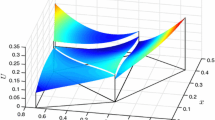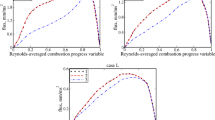Abstract
An effective multiscale treatment of turbulent reacting flows is presented with the use of a stabilized finite element formulation. The method proposed is developed based on the streamline-upwind/Petrov–Galerkin (SUPG) formulation, and includes discontinuity capturing in the form of a new generation “DRD” method, namely the “DRDJ” technique. The stabilized formulation is applied to finite-rate chemistry modelling based on mixture-fraction approaches with the so-called presumed-PDF technique. The turbulent combustion process is simulated for an aero-engine combustor configuration of RQL concept in non-premixed flame regime. The comparative analysis of the temperature and velocity fields demonstrate that the proposed SUPG+DRDJ formulation outperforms the stand-alone SUPG method. The improved accuracy is demonstrated in terms of the combustor overall performance, and the mechanisms involved in the distribution of the numerical diffusivity are also discussed.
Similar content being viewed by others
References
Riley J (2006) Review of large Eddy Simulation of non-premixed turbulent combustion. J Fluid Eng 128: 209–215
Corsini A, Rispoli F, Santoriello A et al (2004) A new stabilized finite element method for advection–diffusion reaction equations using quadratic elements. In: Lajos T (eds) Modelling fluid flow. Springer, Berlin
Corsini A, Rispoli F, Santoriello A (2005) A variational multiscale high-order finite element formulation for turbomachinery flow computations. Comput Method Appl M 194: 4797–4823
Corsini A, Rispoli F, Santoriello A, Tezduyar TE (2006) Improved discontinuity-capturing finite element techniques for reaction effects in turbulence computation. Comput Mech 38: 356–364
Corsini A, Menichini F, Rispoli F, Santoriello A, Tezduyar TE (2009) A multiscale finite element formulation with discontinuity capturing for turbulence models with dominant reactionlike terms. J Appl Mech 76: 021211
Dubois T, Jauberteau F, Temam R (1993) Solution of the incompressible Navier–Stokes equations by the nonlinear galerkin method. J Sci Comput 8: 167–194
Hughes TJR, Mazzei L, Jansen KE (2000) Large eddy simulation and the variational multiscale method. Comput Visual Sci 3: 47–59
Bazilevs Y, Calo VM, Cottrell JA, Hughes TJR, Reali A, Scovazzi G (2007) Variational multiscale residual-based turbulence modeling for large eddy simulation of incompressible flows. Comput Method Appl M 197: 173–201
Rispoli F, Corsini A, Tezduyar TE (2007) Finite element computation of turbulent flows with the Discontinuity-Capturing Directional Dissipation (DCDD). Comput Fluids 36: 121–126
Tezduyar TE, Park YJ (1986) Discontinuity capturing finite element formulations for nonlinear convection–diffusion reaction equations. Comput Method Appl M 59: 307–325
Tezduyar TE, Park YJ, Deans HA (1987) Finite element procedures for time-dependent convection–diffusion reaction systems. Int J Numer Meth Fl 7: 1013–1033
Hauke G, Valino L (2004) Computing reactive flows with a field Monte Carlo formulation and multi-scale methods. Comput Method Appl M 193: 1455–1470
Codina R (1998) Comparison of some finite element methods for solving the diffusion–convection reaction equation. Comput Method Appl M 156: 185–210
Franca LP, Valentin F (2002) On an improved unusual stabilized finite element method for the advective–reactive diffusive equation. Comput Method Appl M 190: 1785–1800
Hauke G (2002) A simple subgrid scale stabilized method for the advection–diffusion reaction equation. Comput Method Appl M 191: 2925–2947
Gravemeier V, Wall WA (2007) A ‘divide-and-conquer’ spatial and temporal multiscale method for transient convection–diffusion reaction equations. Int J Numer Meth Fl 54: 779–804
Hughes TJR (1995) Multiscale phenomena: Green’s functions, the Dirichlet-to-Neumann formulation, subgrid scale models, bubbles and the origins of stabilized methods. Comput Method Appl M 127: 387–401
Brooks AN, Hughes TJR (1982) Streamline upwind/Petrov–Galerkin formulations for convection dominated flows with particular emphasis on the incompressible Navier–Stokes equations. Comput Method Appl M 32: 199–259
Liew SK, Bray KNC, Moss JB (1984) Laminar diffusion flamelet model of turbulent non-premixed combustion. Combust Flame 56: 199–213
Peters N (1984) Laminar diffusion flamelet models in non- premixed turbulent combustion. Prog Energ Combust 10: 319–339
Lentini D, Jones WP (1991) Computational modelling of dump combustors flowfield. NASA CP3078: 623–634
Lentini D (1994) Assessment of the stretched laminar flamelet approach for non-premixed turbulent combustion. Comb Sci Technol 100: 95–122
Corsini A, Rispoli F (2005) Flow analyses in a high-pressure axial ventilation fan with a non-linear eddy viscosity closure. Int J Heat Fluid Fl 17: 108–155
Craft TJ, Launder BE, Suga K (1996) Development and application of a cubic eddy-viscosity model of turbulence. Int J Heat Fluid Fl 17: 108–155
Tezduyar TE, Osawa Y (2000) Finite element stabilization parameters computed from element matrices and vectors. Comput Method Appl M 190: 411–430
Tezduyar TE (2003) Computation of moving boundaries and interfaces and stabilization parameters. Int J Numer Meth Fl 43: 555–575
Tezduyar TE (2007) Finite elements in fluids: stabilized formulations and moving boundaries and interfaces. Comput Fluids 36: 191–206
Mosier SA, Pierce RM (1980) Advanced combustor systems for stationary gas turbine engines, phase I. Review and preliminary evaluation, vol I, Contract 68-02-2136, FR-11405, US Environmental Protection Agency
Pitsch H, Desjardins O, Balarac G, Ihme M (2008) Large-eddy simulation of turbulent reacting flows. Prog Aerosp Sci 44(6): 466–478
ICAO Engine Exhaust Emission Data Bank (2004) Report PWA-4098-6726-01
Kurze J (2005) How to create a performance model of a gas turbine from a limited amount of information. ASME paper GT2005-68537
Author information
Authors and Affiliations
Corresponding author
Rights and permissions
About this article
Cite this article
Corsini, A., Iossa, C., Rispoli, F. et al. A DRD finite element formulation for computing turbulent reacting flows in gas turbine combustors. Comput Mech 46, 159–167 (2010). https://doi.org/10.1007/s00466-009-0441-0
Received:
Accepted:
Published:
Issue Date:
DOI: https://doi.org/10.1007/s00466-009-0441-0




